Tattoo on the forearm realism, photo from: https://www.instagram.com/p/BsmAUG0lOLV/?utm_source=ig_web_copy_link
The plague doctor, whose image is widespread in the tattoo culture of Europe and America. The symbol has a unique meaning associated with periods of deadly epidemics.
This sketch came to the pantheon of CIS images relatively recently. It began appearing in the albums of tattoo artists around 2012. So what is the secret of the attractiveness of a frightening and mysterious image?
Plague doctor tattoo meaning
To better understand the meaning of a tattoo, it is worth turning to the history of the appearance of the image. In the mid-14th century, a terrible disease claimed more than 25 million people. The disease broke out due to climate change, overpopulation and lack of sanitation. Medicine of that period could not answer how to deal with the epidemic. The black plague claimed the lives of entire settlements in weeks and days.
To fight the disease, teams of “plague doctors” were created. They provided medical assistance and burned homes and the remains of the dead. In the minds of people of that period, the plague was a living and intelligent creature.
That is why the sight of the orderlies was supposed to scare away the deadly disease. It is worth noting the fact that in medieval Europe there was a strange artistic perception of the environment.
Under the pressure of general hysteria, the physician Charles de Lorme in 1619 created the first plague doctor mask. It was a cross between the Venetian Nose mask and an interpretation of a crow's head. Since crows are scavengers by nature, the comparison seems logical.
In addition to its threatening appearance, the mask served practical functions. A mixture of vinegar, wormwood and strong-smelling herbs was poured into the beak. The fumes acted as protection against miasma from diseased bodies. The design can be called the first respirator.
In addition to the mask, the outfit included a long leather cloak, a buff covering the area from the collarbones to the face. The equipment was complemented by tight leather pants, heavy boots, high gloves and hats. All elements had to be sewn from waxed leather or rough canvas soaked in wax.
In the views of contemporaries, the plague doctor is a symbol of fatalism. In his image lies inevitability, fate and impending disaster. However, thanks to the development of the image in the culture of the plague doctor tattoo, its meaning has increased. The interpretation of the symbol was largely influenced by the gaming industry and media.
 Tattoo on hand, photo from: https://www.instagram.com/p/BlxEFvAl5GR/?utm_source=ig_web_copy_link
Tattoo on hand, photo from: https://www.instagram.com/p/BlxEFvAl5GR/?utm_source=ig_web_copy_link
Tattoo symbolism:
- black humor;
- unreasonable optimism;
- evil irony;
- victory over death;
- son of death;
- order amidst chaos;
- sarcastic attitude towards danger;
- complex nature;
- "not of this world";
- fun amid the apocalypse;
- gothic way of thinking;
- a sober outlook on life.
Tattoo ma'am began to develop on Russian imageboards. The occasion was a canary costume made by St. Petersburg artist Nikolai Kopeikin for his daughter for a matinee.
The strange mask was recognized by domestic users as a plague doctor. By 2012, the image became part of tattoo culture, filled with unique semantic content. It was he who influenced the interpretation of the image not only in Europe, but also in America.
The meaning of tattoos for girls
The plague doctor tattoo is popular among girls whose personality is classified as a Balzac type. These are attentive observers who approach life with a healthy dose of skepticism. You can recognize a potential tattoo bearer by her good manners, neat appearance and balanced character. In communication they prefer black humor, which is most often funny.
Tattoo meaning for women:
- durability;
- bravery;
- bright personality;
- a sober assessment of the situation;
- respect for life and death;
- dark humor;
- strategy;
- irresistible charm;
- wit.
Girls' tattoos are individual in nature. Each wearer has a distinct personality, which is expressed in the tattoo. The style and form are selected carefully, each element carries a semantic load. Thanks to the female audience, the image of the plague doctor received more than 1000 variations of execution and influenced the formation of tattoos on two continents.
The meaning of tattoos for men
The Shepherd of the Plague is a tireless healer with high spirits. This is a popular tattoo whose meaning for men is associated with sarcasm and death. Men are more conservative in their style. They stick to traditional and historical reconstructions.
Interpretation of the symbol for men:
- divine revelation;
- Gothic;
- bitter irony;
- indifference to worldly things;
- sarcasm;
- sensory perception of the world;
- the power of fate;
- order and law;
- bitterness of parting;
- balance of life and death;
- loyalty to ideals;
- diligence;
- inquisitive mind;
- a misunderstood genius;
- talented inventor.
If we characterize the carrier from the point of view of socionics, this is a typical Dreiser. He is efficient, pedantic and at the same time treats any event in his life with peculiar humor. Men's tattoos look like works of art. They are full of signs and meaning, distinguished by attention to detail.
Style selection
The plague doctor is a universal image that looks good in both realism and graphics. A mask with a beak is ideal for trash polka, new school, neo-traditional or graphic.
Black and white, blackwork or traditional techniques will enhance the sense of fate. Old school, Chicano, engraving or baroque will help to enhance the share of black humor. Realism is considered the leader for the plague doctor.
Place for tattoo
The area of the arms, back and legs can reveal the full depth of the image. The drawing has no restrictions on the area of application. It can be hit on the shin or thigh. In this case, the gender or age of the future owner does not matter.






A sketch in the author's style close to the best one to print on the forearm, the side area from the line of the ribs to the waist. Girls prefer to have a doctor tattoo on their shoulder, forearm or shoulder blade. Among men, it is common to apply a pattern to the calf.
As an image of a plague doctor, the sketch expresses the emotional values of the owner. Think about your desire to get such a contrasting tattoo. Figure out what attracts you to him. This will help to collect as many facts as possible, which the tattoo artist will use in drawing up the design.
Do not take ready-made works, since copying the image of a plague doctor is considered bad form. Photos from the Internet can only be used as an illustration of the style in which you want the tattoo.
Video – plague doctor tattoo, photo gallery
Let's talk about the possible meaning of the plague doctor tattoo. This image in current European culture is surrounded by an aura of mystery and mysticism. It became popular thanks to the traditional costume worn by real-life plague doctors, and, of course, the feeling of doom that they caused by their mere appearance. It is not surprising that such a strong and unambiguous symbol has become one of the popular themes for tattoos.
However, in fact, there was nothing mythical in the real profession. Danger, fear, stench and death - that's what really surrounded the plague doctor.
Brief historical excursion
The image of the plague doctor and all the symbolism associated with it belongs exclusively to European culture.
In overpopulated European cities, where complete unsanitary conditions reigned, the plague developed into a pandemic of truly terrifying proportions. The medicine of that time can hardly be called medicine in our current understanding. It was rather a mixture of certain theological ideas and outright quackery. Even minor illnesses periodically ended in death, let alone such a dangerous disease as the plague. Ordinary doctors could not prevent the spread of the disease and cure the sick. The activities of the plague doctors were also not very successful, but they still managed to achieve some positive results. Their work was mainly limited to cutting and cauterizing buboes and bloodletting. Due to the danger to which they were constantly exposed, plague healers could not be full members of society and have contact with the general public; they were often placed under quarantine.
Such a recognizable costume appeared only at the beginning of the 15th century, although the profession itself existed since the middle of the 13th century. The final design of the suit was designed by French physician Charles de Lorme. The main purpose of this robe is to protect the doctor from infection. Until this point, doctors wore different protective clothing, and it was not until 1619 that a standard suit was developed.
The mask with a bird's beak gave the doctor a certain resemblance to the Egyptian god Thoth and was designed to ward off the plague. However, it served not only the function of a talisman. Mixtures of medicinal herbs with a strong odor were placed in the beak, which saved the doctor from the stench of the plague. The mask also had special glass inserts to protect the eyes. It was believed that red glass could make a doctor invulnerable to disease.
In addition to the mask, the costume consisted of a long cloak covering the doctor from neck to ankles, tight trousers, gloves, boots and a hat. All these elements were sewn from waxed leather.
By the way, the well-known Nostradamus was also a plague doctor at one time.
Plague doctor in tattoo culture
The plague doctor tattoo is the choice of brave people who are not afraid to seem too gloomy or be misunderstood. This image does not know gender differences; the plague doctor is depicted on their bodies by both men and women, because it indicates character traits or worldviews inherent in both sexes. Such a tattoo can have more than one meaning:
- Fatalism. The plague doctor depicted on the body suggests that its owner believes in the inevitability of fate. This is often also associated with pessimism, a lack of faith that a person can choose his own path in life, change his destiny, surrenders himself to the will of circumstances and is ready to go with the flow, wherever it leads him.
- Calling Death. Death is the constant companion of the plague doctor. Such a tattoo indicates that a person is ready to face death and has no fear of it.
Of course, everyone is free to understand the meaning of the plague doctor tattoo in their own way; each person can put their own meaning into the image, add their own details, it all depends on the imagination of the customer and the artist.

Style selection
Realism is considered one of the most difficult styles to execute. For the work to be truly realistic, the master must also be a talented artist. Portraits and images of animals are most often used in this style, and landscapes by experienced craftsmen are breathtaking. A realistic plague doctor can look really cool.
Another suitable style is . He just screams: “down with banality and templates!” Finding beauty in the disgusting, exalting the repulsive - this is the essence of trash polka. The plague doctor is associated with disease, noxious stench, decay and the inevitability of death. Isn't this the right look for this style? Wide, careless strokes of red and black will leave no room for routine and monotony.

Selecting a location
Most often, images of a plague doctor have an oblong shape, so they will look great on the shoulder, forearm, thigh or calves. Getting a tattoo on these places is also the least painful. There are also large-scale works on the entire back or on the ribs. In this case, the closer the master’s needle gets to the bone, the stronger the pain will be.
The tattoo of a laid-off doctor is the doctor’s own bitter medicine. Optimization and healthcare reform became a response to the well-known “May” decrees of the President of the Russian Federation.
The head of state, in particular, set the task: a doctor’s salary should be twice the regional average. But it’s unlikely that anyone five years ago would have imagined that the Ministry of Health would try to achieve the planned indicators through financial maneuvers within the health care system itself. The May presidential decrees, as a result, were implemented in a barbaric way. Despite assurances about the success of healthcare reform that are regularly heard from officials, doctors themselves are not at all happy with what is happening. Three quarters of Russian doctors and nurses believe that optimization of healthcare actually leads to a decrease in the availability of healthcare services for the population. And the vast majority of health workers (92.7%) admit that due to the increased workload on hospital and clinic staff, the quality of their work is deteriorating. These are the main conclusions based on the results of a sociological survey conducted by the Independent Monitoring Foundation “Health”.
Plague doctor tattoo in English plague doctor - medieval doctor, historical period, pre-modern time, easily recognizable by its characteristic mask, similar to a bird's beak. This was part protective suit: In addition to the fact that the terrifying mask supposedly warded off disease (which was believed to be carried by birds), it was filled with medicinal herbs that protected the doctor from the stench of the plague, and those around him from the smell of garlic, which the doctor chewed for self-defense. Possible costume tattoo details a wax-soaked cloak, tight trousers, gloves, boots and a hat.
His job was prestigious and highly paid, although not conducive to contacts with the public - tattoo as an impulse to find oneself in new conditions.
Mystical, romantic-infernal external type of tattoo will have a noticeable influence on the views, attitude to the problem of laying off doctors and culture modern medicine in Russia, under healthcare understanding not so much medicine as such, but criticality health categories, problems of Russian medical qualifications, integrity of physical and emotional status, compensation high level of stress among the country's population.
Thanks to plague doctors the famous Venetian mask appeared, accentuated the idea of healing as an art, as well as a regular character in the Italian " Commedia dell'arte».





























